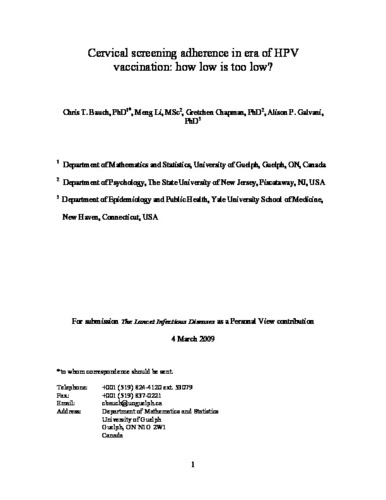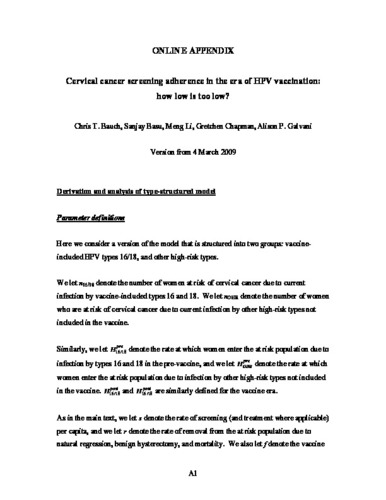| dc.contributor.author | Bauch, Chris T. | |
| dc.contributor.author | Li, Meng | |
| dc.contributor.author | Chapman, Gretchen | |
| dc.contributor.author | Galvani, Alison P. | |
| dc.date.accessioned | 2023-05-01 18:32:54 (GMT) | |
| dc.date.available | 2023-05-01 18:32:54 (GMT) | |
| dc.date.issued | 2010-02-10 | |
| dc.identifier.uri | https://doi.org/10.1016/s1473-3099(10)70004-9 | |
| dc.identifier.uri | http://hdl.handle.net/10012/19379 | |
| dc.description | The final publication is available at Elsevier via https://doi.org/10.1016/s1473-3099(10)70004-9. © 2010. This manuscript version is made available under the CC-BY-NC-ND 4.0 license http://creativecommons.org/licenses/by-nc-nd/4.0/ | en |
| dc.description.abstract | The recently licensed human papillomavirus (HPV) vaccine can prevent most cervical cancers. However, continued screening is necessary in vaccinated women to prevent cancers caused by high-risk HPV types not included in the vaccine. In the HPV vaccine era, there is new concern that vaccinated women will reduce their rate of screening due to an exaggerated sense of protection from the vaccine. Some have suggested this could paradoxically lead to an increase in the incidence of cervical cancer cases. Here, we present a simple mathematical model suggesting that it would be difficult for such a perverse outcome to occur. We make a conservative estimate that screening rates in vaccinated women would have to decline by at least 39% for the incidence of cervical cancer in a population to increase relative to pre- vaccine levels. We also present results from a new nationwide survey of attitudes in the United States that are consistent with a decline of less than 39%. Finally, the model uncovers a surprising observation that in populations where screening rates are high in the pre-vaccine era, screening rates in vaccinated women can fall less before perverse outcomes start to occur. | en |
| dc.language.iso | en | en |
| dc.publisher | Elsevier | en |
| dc.relation.ispartofseries | The Lancet Infectious Diseases; | |
| dc.rights | Attribution-NonCommercial 4.0 International | * |
| dc.rights.uri | http://creativecommons.org/licenses/by-nc/4.0/ | * |
| dc.subject | cervical screening | en |
| dc.subject | mathematical model | en |
| dc.subject | cervical cancer | en |
| dc.subject | human papillomavirus vaccine | en |
| dc.title | Cervical screening adherence in era of HPV vaccination: how low is too low? | en |
| dc.title.alternative | Adherence to cervical screening in the era of human papillomavirus vaccination: how low is too low? | en |
| dc.type | Article | en |
| dcterms.bibliographicCitation | Bauch, C. T., Li, M., Chapman, G., & Galvani, A. P. (2010). Adherence to cervical screening in the era of human papillomavirus vaccination: How low is too low? The Lancet Infectious Diseases, 10(2), 133–137. https://doi.org/10.1016/s1473-3099(10)70004-9 | en |
| uws.contributor.affiliation1 | Faculty of Mathematics | en |
| uws.contributor.affiliation2 | Applied Mathematics | en |
| uws.typeOfResource | Text | en |
| uws.peerReviewStatus | Reviewed | en |
| uws.scholarLevel | Faculty | en |



